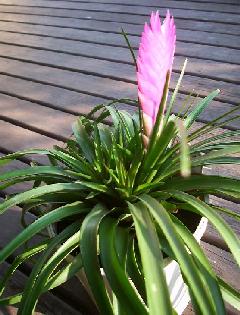
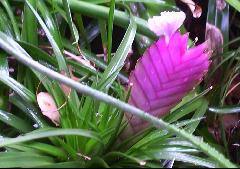
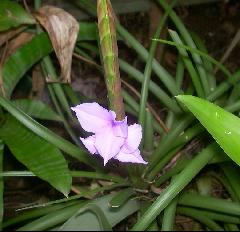
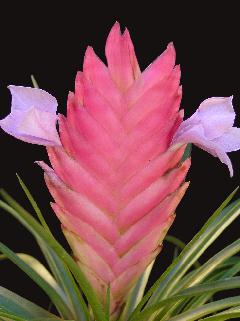
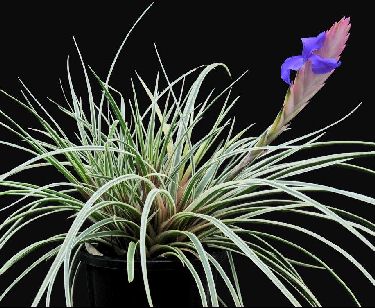
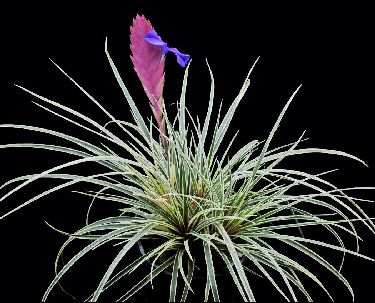
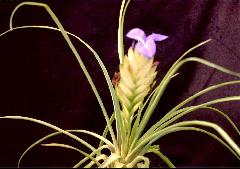
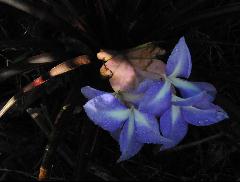
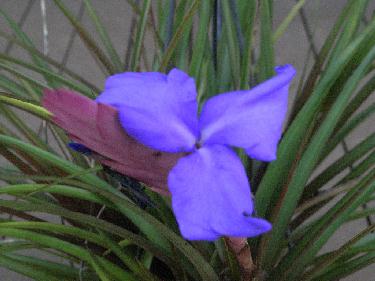
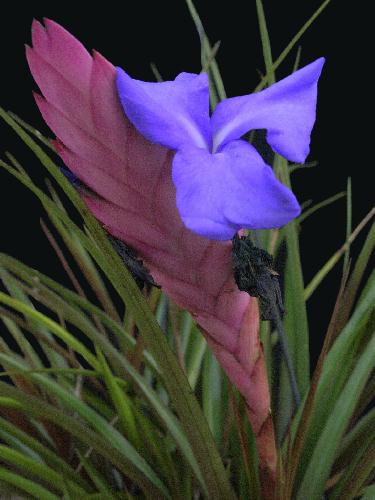
Tillandsias with Paddle-shaped inflorescences by D Butcher 2000
(anceps, cyanea, lindenii, pretiosa, umbellata)
There has been some interesting photographs submitted to the Internet about this group and it shows that there is some confusion as to names. First we have to ignore the use of colour purely because the beta cyanin in the blue petals creates havoc with colour film irrespective of brand and produces reddish tones. We have argued this point for many years in Adelaide and have never come up with an answer. I had thought that digital cameras might have solved the problem but it seems that the make of camera also effects the result. So the finer points of colour are out.
I thought I would solve this naming problem for good and all and draw up a chart. This follows:
| . Name | . Scape | . Spike | . Axis visible anthesis | . Petal | . White centre | . Floral bracts nerved |
| . anceps | . short | . 10-15cm x 5.5cm | . no | . 5.5cm long narrow and spreading | . no | . no |
| . cyanea | . short | . 16 x 7cm | . no | . 8cm long wide and spreading | . no except v. tricolor | . no |
| . lindenii | . long | . 20 x 5cm | . no | . 7cm long wide and spreading | . yes | . yes |
| . pretiosa | . long | . 20 x 11cm | . yes | . 8cm long wide and spreading | . yes | . very strong |
| . umbellata | . long and thin | . 6 x 3cm | . yes | . 7cm long wide and spreading | . yes | . yes |
“The name, "Tillandsia lindeni", sets a new high for confusion in the Bromeliaceae. As used here it applies to the "long-scaped” species first noted by Regel, and not to the "short-scaped" species that E. Morren described as new under the same name. Regel, after publishing his species twice as "lindeni," for no explained reason changed to "lindeniana" for his third and best-known description, and a year later proposed "morreniana" as a new name for Morren's species to avoid duplication of the "lindeni" he now disowned. Morren, not to be outdone in weird reasoning, proceeded to make Regel's earlier species a variety "regeliana" of his, the later, "lindeni."
Regel and Morren argued back and forth in print over the names and status of their two finds and were later further confused by Andre. Meanwhile, the horticultural writers, struck by the great beauty of the plants, published a profusion of notes and illustrations without stopping to verify names and identities. In several instances they managed to illustrate "lindeni" of Regel while labeling it "lindeni" of Morren.
Regel contented himself in arguing the priority of his name and the specific distinction of the two entities involved. Morren considered them varieties of the same species and went on to add further varieties, still under the wrong "lindeni," with the paradoxical result that three of them must now be transferred from "lindeni" of Morren to "lindeni" of Regel, since the two species were founded independently, and on different types.
Again we meet confusion in the battle of Tillandsia lindeni. Both species were collected by Wallis and, as reported by Regel, one came from Zozoranga in Ecuador and the other from Huancabamba in Peru. Morren claimed that they were but a single collection, but later collections would refute this and also indicate that Regel had reversed species and localities. Actually, all collections since the types indicate that the species with the long scape is Peruvian and that with the short is Ecuadorian.
The earliest specimen of Tillandsia lindeni to be illustrated was few-flowered and rather resembled T. umbellata, but later more vigorous plants had larger inflorescences that contrast sharply with that species.”
After all this investigation you would have thought that Lyman Smith would have known all there was to know about this group but we find that his T. cyanea var. elatior is now treated as a T. pretiosa.
Let us also look at THE chart to see the differences between T. lindenii and T. pretiosa. The T. pretiosa spike is twice as long as it is wide, in fact quite a fat fellow, and in the photograph by Werner Rauh in BSIJ #6 1984 we clearly see the axis at the time of actual flowering. The photograph from Jose Manzanares is not as clear cut but it does show the non-flowered bracts at the top of the spike much closer together. If we look at the photograph on page 209 in Baensch's Blooming Bromeliads (1994) we will see no changes in the positions of the floral bracts and a somewhat skinny spike suggesting this is T. lindenii or a hybrid of it.
If you have anything that can add to our knowledge of this group please let us know.
Key from Mez 1935
b) Inflorescentia densa, optime flabellata.
l. Bracteae sepalis permulto longiores; petalorum laminae ellipticae.
- § Bracteae ad 0,125 m longae ==> 332. monstrum
- §§ Bracteae ad 40 mm longae ==> 333. anceps
2. Bracteae sepalis paullo longiores vel ea subaequantes; petalorum laminae maximae, suborbiculares.
- § Inflorescentia multiflora; flores sibi superpositi.
- - + Sepala rotundata
- - - ° Scapus elongatus; petala ad faucem albo-maculata ==> 334. Lindeniana
- - - °° Scapus abbreviatus; petala aequaliter cyanea ==> 335. Morreniana
- - ++ Sepala acutissima ==> 336. pretiosa
- §§ Inflorescentiae pauciflorae flores juxtapositi adspectu subumbellati ==> 337. umbellata
Tillandsia guatemalensis = now Tillandsia cyanea
No, that is not a typing error above! Tillandsia cyanea is now the new correct name for the commonly cultivated species Tillandsia guatemalensis. This of course is made more confusing by the fact that another very common species we knew for many years as Tillandsia cyanea (now reclassified as Wallisia cyanea, with its pink, paddle-shaped inflorescence) looks nothing like T. guatemalensis!
Confused? How could this be you ask?! …It's a bit of a long story, but it's worth explaining in simplified terms so we can understand how and why species get their names and also why they sometimes get changed.
Firstly, in this instance one of the reasons was confusions and misinformation with genera and species' names by botanists way back in the 1850s and 60s when these plants were first being discovered and
described. This was a very common problem before things like airmail, and later on the internet, where early botanists from different countries were often oblivious to what was going on elsewhere, or unable
to get information in a timely manner. They had to wait for journals to be published, then ensure they received them, but by then it was often too late. When a new species is described, the year and the name it is first described as always takes precedence. So if the same plant (or similar-looking one) is described by someone else with a different genus or species name after that date, the subsequent name can be reverted back to the original name, if it can be proved they are actually the same species at any time in the future.
So, let's look at this process and summarize the timeline of what occurred in this case:
The plant we have come to know as T. guatemalensis was actually first described as Allardtia cyanea in 1852. The name 'cyanea' means 'sky blue', in reference to the blue (violet) colour of the petals. Then in 1854-55 Platystachys cyanea also appeared; the Platystachys genus was later synonymized to Tillandsia, so this was probably the same plant as described two years earlier.
Then in 1864, another very similar species, T. excelsa, was published, followed by other similar lookalikes: T. columnaris (1889), T. costaricana and T. werckleana (1903), T. selleana (1929), T. guatemalensis (1949, by L. B. Smith), T. uyucensis and T. uyucensis f. minor (1965) and T. marcolensis (1991).
We must remember that the authors of all of these species at the time would have believed 'their' plant was different in some way, or came from a different habitat to a predecessor and hence was deserving of its own taxon name. Or, they were simply not aware the others existed at the time due to geographical, communication and publishing barriers of the early days, as mentioned above. In the meantime, like Platystachys, the Allardtia genus was also synonymized to Tillandsia in 1879, but the species name is still retained. Therefore the earliest name with 'precedence' then becomes Tillandsia cyanea (1852).
From the above list of species, we can see that the name T. guatemalensis was first proposed and published by Smith in 1949, almost one hundred years after the original Allardtia (Tillandsia) cyanea. This has proved to be a taxonomic error.
In the revision of Tillandsioideae by Barfuss et al (2016), they rightly assert the following;
"Allardtia cyanea A. Dietr. (1852) is a valid and legitimate name.
The name Tillandsia cyanea in Koch's article (1867) was not validly published by Koch, as he did not accept the name for the exhibited plant in Paris (which was a Bromelioideae according to the text).
This means, the name Tillandsia cyanea was still available at that time. The combination of Allardtia cyanea A. Dietr. under Tillandsia by Morren as Tillandsia cyanea (A.Dietr) E. Morren (1879) for this taxon is therefore valid and legitimate, because Tillandsia cyanea was still available. The new name Tillandsia guatemalensis L.B. Sm. (1949) for Allardtia cyanea E. Morren is illegitimate."
Secondly, now that the naming precedence issue is cleared up, this is where modern taxonomy and research finally enters the picture to prove the reclassification of the other allied species as well. In recent years, Eric Gouda and Reino Koopmans in The Netherlands studied this whole T. guatemalensis group and published their findings in 'Die Bromelie', the German Bromeliad Society Journal earlier this year. They looked in detail at the differences in several mature plants from batches of seed sourced from different localities in Central America. They consulted the original pressed herbarium type specimens from around the world, along with the botanical descriptions and identification keys of each of the early species names mentioned above. In summary, their research showed that the variation in the seedlings and some herbarium specimens (to do with leaf tip shape, rosette size, inflorescence size and the sizes of some of the floral parts) was quite large. In fact they found the variations were large enough to encompass ALL of these species and overlap the descriptions of most, if not all of them within reason, also taking into account some description anomalies. This means they are actually all conspecific (the same) and should therefore be treated under one species name only, not as several different species. As mentioned earlier, the first description takes precedence, so because as we now know the correct name for T. guatemalensis is T. cyanea, therefore all of the other subsequent species listed above, including T. excelsa, can also be synonymized to T. cyanea too.
The Gouda and Koopman observations of a number of highly variable forms also corroborates what is seen in habitat and in the plants we grow in cultivation. In Central America, what has previously been known as T. guatemalensis is found growing as an epiphyte over a wide range in numerous countries at different altitudes, including on the Caribbean islands of Cuba, Jamaica and Haiti. Plants are seen in both large and small-sized rosettes, with red, green or speckled red leaves. The inflorescences may be tall to well over a metre high, stacked with many spikes, or short and compact in either red or green-bracted forms. In New Zealand we appear to have at least four different clones: two larger forms, one with redspeckled, olive-green leaves to around 30-40cm wide and a red inflorescence, the other with grassgreen, glossy leaves and also a greenish inflorescence. There are also two small to medium sized forms around 25-35cm wide with green leaves and a tall red inflorescence around 60-80cm tall, the other has a shorter red inflorescence around 30-50cm tall. There may well be more variations around too, but these are the common ones I have been able to collect to date.
So what about the old Tillandsia (Wallisia) cyanea? This is another historical story that's even more difficult to understand!
In very basic terms, it was originally confused with Tillandsia lindenii back in the late 1860s and then L. B Smith made another error in interpreting the literature and redescribed it as Tillandsia cyanea in 1951, when he should have used a different name in this case. Since then, the name T. cyanea prevailed in cultivation until DNA and morphological studies proved these species were in fact a genus of their own and should be separate to Tillandsia.
Hence, as per the rules of precedence discussed above, it was rightfully reverted by Barfuss et al in 2016 to the original genus Wallisia, that was first described for these species in 1870.